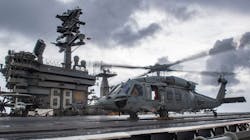U.S. and allied anti-submarine warfare (ASW) experts demonstrate networking sensors to find enemy submarines
WASHINGTON – The U.S. Navy, Japan, Australia, India, Canada and Japan just finished up a massive, coordinated, multilateral anti-submarine warfare (ASW) exercise to sharpen a collective allied ability to find, track, and potentially attack Chinese submarines in the Pacific. Kris Osborn at The National Interest reports Continue reading original article
The Military & Aerospace Electronics take:
17 Feb. 2021 -- Now in its third year, the Sea Dragon 2021 exercise used U.S. Navy Poseidon maritime patrol aircraft, surface warships, and submarines to network tracking data, alternate search missions among countries, and share threat data across an allied coalition in real time, a Navy report says.
This kind of integrated allied operation is quite significant, yet its success almost surely depends entirely on the effectiveness of allied networking, as ships, submarines, aircraft and command and control nodes from all involved countries would need to sustain connectivity, share data and hand off a threat track from platform to another.
At the conclusion of the Sea Dragon exercise, all participating countries worked in shifts to track a U.S. Navy Los Angeles-class submarine, using cutting edge sensors and other anti-submarine warfare techniques. These likely include the use of air-dropped sonobuoys, surface-ship towed sonar arrays and sub-hunting aircraft built with a new generation of high-fidelity, long-range surveillance technology.
Related: Navy researchers to brief industry on mobile anti-submarine warfare (ASW) deep-water sonar
John Keller, chief editor
Military & Aerospace Electronics
